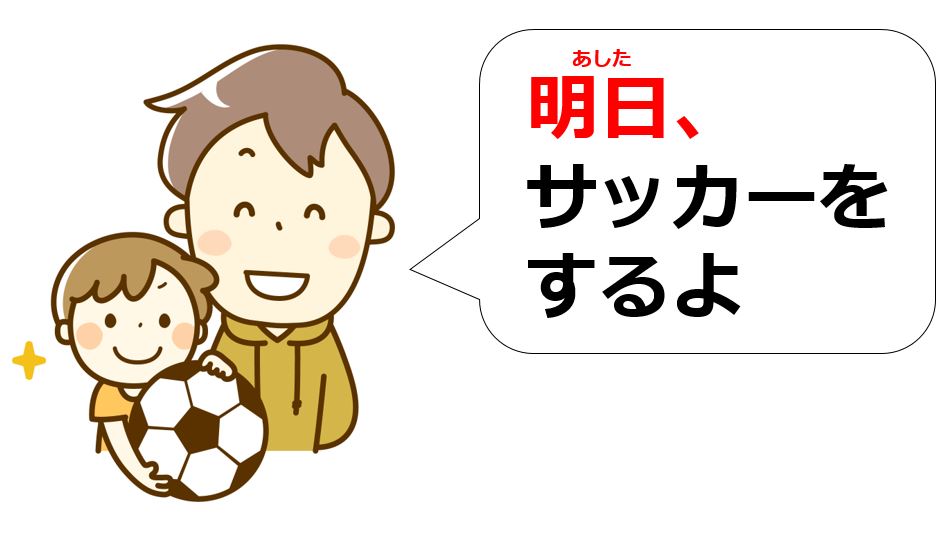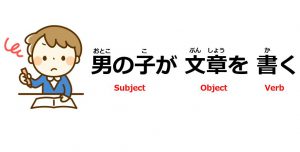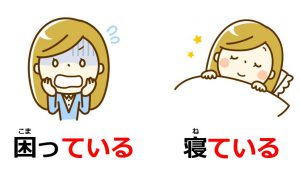You will start learning Japanese tenses and aspects. In the previous sections, we didn’t mention them, and generally used future tense. By understanding the usages of tenses and aspects, you will be able to communicate with people more accurately. Here, you will learn both present and future tense.
Plain Forms Express Constant States, Customary Actions and Future Tense
| Table of Contents Present Tense Future Tense The Particle に with Temporal Nouns |
Present tense can be further divided, e.g. constant states, customary actions, progressive actions, and resultant states. In this lesson, we’d like to focus on the ones expressed by the plain form. Since the plain form can express both present and future tense, you should have a clear picture about its usage.
Present Tense
Constant States
| 暑い日は | 水が | たくさん | 要る / 要ります |
| Topic | Subject | Adverb | Verb |
| As for hot days, we need a lot of water. *要る is an intransitive verb in Japanese. |
|||
Constant states are states that last constantly and are usually represented by nouns and adjectives as the following examples show because those kinds of states don’t normally change. Then, some verbs like “要る: to need” and “値する: to deserve” also indicate constant states. Just like English doesn’t say “I’m needing it,” Japanese just uses those verbs in the plain (dictionary) form.
| 人を助けることは賞賛に(値する / 値します)。 Helping people deserves praise. |
| 猫はかわいい(です)。 Cats are cute. |
| 子供は元気(だ / です)。 Children are lively. |
| 私は日本人(だ / です)。 I’m Japanese. |
You can also express constant states in future tense by using the plain form with temporal nouns.
| 明日は水がたくさん(要る / 要ります)。 As for tomorrow, [we] will need a lot of water. |
Customary Actions
| 田中さんは | いつも | 大きい声で | 笑う / 笑います |
| Topic / Subject | Adverb | State | Verb |
| Tanaka-san always laughs with a loud voice. | |||
Customary actions are actions that you are not doing right now, but are habitual. You can express such actions by using the plain form. This concept is often used with adverbs or temporal nouns such as “いつも: always” and “毎日: everyday.”
| お酒を(飲む / 飲みます)。 [I] drink alcohol. |
| 佐藤さんはタバコを(吸う / 吸います)。 Sato-san smokes. |
| 毎朝、顔を(洗う / 洗います)。 [I] wash my face every morning. |
| よく日本の歌を(歌う / 歌います)。 [I] often sing Japanese songs. |
Future Tense
| [私は] | 今から | 学校に | 行く / 行きます |
| [Topic / Subject] | Adverb | Destination | Verb |
| [I] will go to school from now on. | |||
The plain form of verbs expresses future tense if not describing constant states or customary actions. Since we use the same form for different usages, you need to judge which function verbs work based on the context. Here is a comparison.
| 毎朝、ごはんを(食べる / 食べます)。 [I] eat a meal every morning. |
| 今からごはんを(食べる / 食べます)。 [I] will a meal, starting now. |
The following example can be interpreted as both a customary and future action. The context will determine the meaning. If you’d like to specify, you need to use adverbs or temporal nouns.
| 朝7時にごはんを(食べる / 食べます)。 [I] (will or generally) eat a meal at 7:00am. |
[adsense]
The Particle に with Temporal Nouns
As you may have noticed, adverbs and temporal nouns are the keys to determining tense. Since you have already learned adverbs in the previous lesson, we will focus on temporal nouns here. Some learners are confused by the placement of the proper particle.
Specific Time
The particle に expresses specific time, and thus you have to attach に when you use words like the following.
1時: 1 o’clock
1日: 1st (date)
1月: January
月曜日: Monday
2000年: year 2000
| 夜の7時にお客さんが(来る / 来ます)。 [My] guest will come at 7:00pm. |
| 15日にアメリカへ(行く / 行きます)。 [I] will go to the US on the 15th. |
Don’t be confused. Other particles such as は and が can be used when temporal nouns are a topic or a subject.
| 夜の11時は危ない(です)。 As for 11:00pm, [it] is dangerous. |
| 15日が私の誕生日(だ / です)。 The 15th is my birthday. |
Relative Time
It is not necessarily the case that temporal nouns always indicate specific time. For example, if you have only the word: “明日 tomorrow,” you cannot specify what date it is. In this case, you don’t have to use に. Here is the vocabulary list.
今日: today
昨日: yesterday
明日: tomorrow
今: now
今週: this week
来週: next week
先週: last week
今月: this month
来月: next month
先月: last month
今年: this year
来年: next year
去年: last year
毎日: every day
毎朝: every morning
毎晩: every evening
| 毎日、歯を(磨く / 磨きます)。 [I] brush my teeth every day. |
| 手紙はいつ(届く / 届きますか)? => 来週(届く / 届きます)よ。 When will the letter arrive? => [It will] arrive next week. |
In practice, some native speakers use the particle に with the above words even if it’s not grammatically correct. In addition, there is an expression to emphasize specific time by using the combined particle には (specific time + contrast). This is applicable for the above words and very natural.
| 手紙はいつ(届く / 届きますか)? => 来週には(届く / 届きます)よ。 When will the letter arrive? => (Emphasis) [It will] arrive next week. |
Time with Range
If temporal nouns can be specified, but have some ranges, either using the particle に or not is natural. If you’d like to emphasize time, you should use に.
朝: morning
昼: daytime
夕方: evening
夜: night
春: spring
夏: summer
秋: fall
冬: winter
| 次の春(に)大学を卒業(する / します)。 [I will] graduate from university next spring. |
| 趣味は朝(に)散歩をすること(だ / です)。 [My] hobby is walking around during the morning. |
Summary
- The plain form expresses present tense (constant state and customary actions) and future tense.
- Specific time requires the particle に while relative time does not.
- If temporal nouns have a range, either using the particle に or not is natural.
You have learned future tense and some usages of present tense. Since we use the exact same form, you need to judge functions based on the context. Then, what about other usages of present tense? In English, you change the form to express progressive actions like “I’m doing it.” This is what you will learn next.





